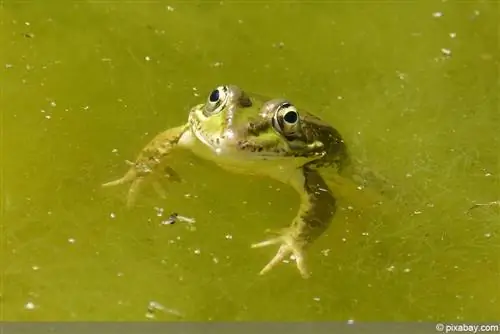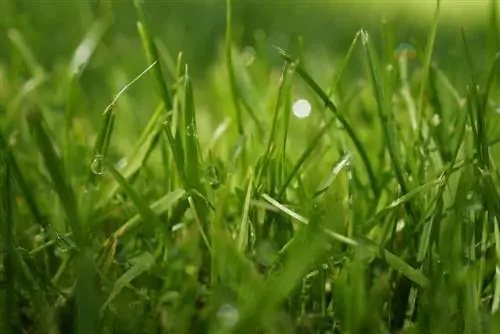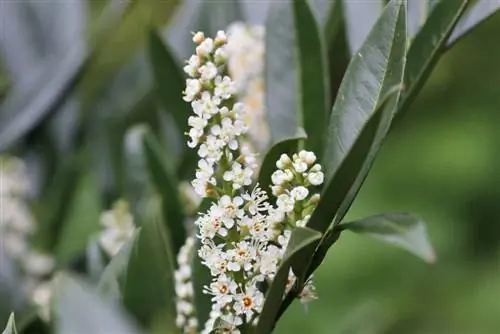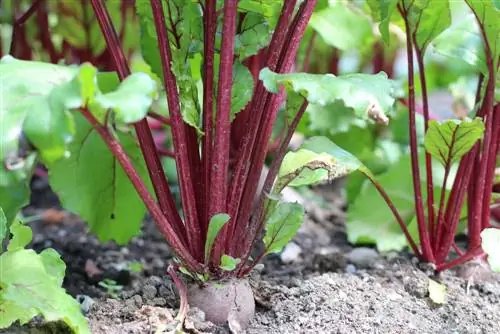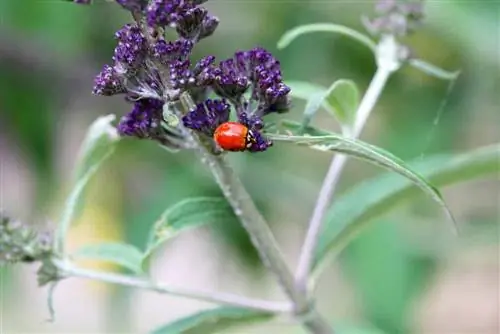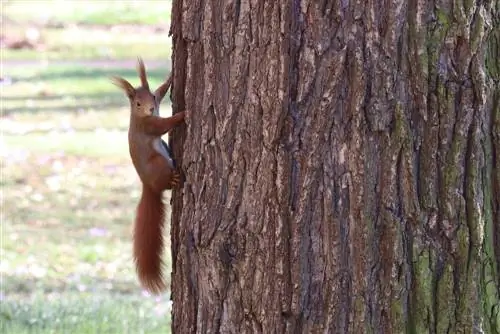- Author admin [email protected].
- Public 2023-12-17 03:39.
- Last modified 2025-01-24 12:45.
As time approaches winter, nature has equipped frogs and toads with a protective mechanism that allows them to survive the cold season without freezing to death or starving due to lack of food. This automatic mechanism causes them to go into hibernation, as is the case with most amphibians. In order to let them overwinter undisturbed and how you can help give them an optimal wintering experience, you should know the following about frogs and toads in the winter time.
Wintering
Frogs and toads are cold-blooded animals that adapt to the outside temperature. In the cold winter time, their body temperature drops to almost 0 degrees Celsius and they fall into hibernation. To do this, they need a safe place where they can survive the winter undamaged. Basically, frogs and toads prefer moist to wet areas. Depending on the species, they look for a damp spot in the ground or hibernate underwater in ponds and rivers.
The latter is possible because they have a specific way of breathing so that they can absorb enough oxygen even under water. The most suitable places for overwintering are those in which they can survive the winter undisturbed and protected from possible “enemies”.
Winter torpor
As soon as the outside temperatures consistently fall below 10 degrees Celsius, the frog and toad body begins to go into winter torpor. These temperatures can usually be expected between mid-October and mid-March. During this time you will no longer see or hear the Quakers at all or only rarely.
The basic requirement for survival in the cold is that the body temperature drops evenly with the ambient temperature. This is necessary in order to slowly reduce the metabolism and also reduce all other organ functions such as breathing and heartbeat almost to a standstill. Movements are then no longer possible.
If the temperatures drop above 10 degrees Celsius again during the winter, the winter rigidity ends during this period and Quakers become agile again. If the outside temperature falls again, they will go back into winter torpor. It can happen that they hop through the gardens several times during the winter season and become rigid in winter as the temperatures drop again.
Although these animals receive cold and physical protection from hibernation, they do not cope well with temperatures below 0 degrees Celsius. Lowering and adjusting the body temperature is usually only possible down to 0 degrees Celsius if this amphibian species is to survive. If the outside temperature and thus the body temperature falls below this, the body stops all metabolic and organ functionality. The animal dies. Only a few exceptions survive sub-zero temperatures for a short time.
Food
Due to the immobility during the hibernation, these amphibious animals do not need food to provide them with daily energy, as the body hardly burns any energy in the undisturbed hibernation, especially since they cannot go looking for food due to the immobility. In order to get through the winter and still keep the body system alive and, especially after the winter torpor, to have enough energy to release the frogs and toads from the winter torpor, they eat plenty of food in autumn.
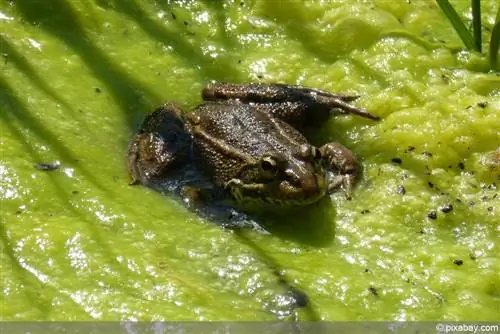
In particularly long, cold winters, the “winter fat” you eat is often not enough. Some animals then manage to escape from hibernation, but no longer. It is therefore particularly important that the frog and toad are not disturbed during the winter period. Disturbances would cost the animal additional energy, which they might lack at the end of the icy winter season and they would no longer be able to emerge from hibernation alive.
Land wintering
Most frog species prefer a hole in the ground, while toads thrive in a compost heap in winter during their hibernation period. Unlike many other animal species, the frog or toad does not need a nest in the winter months. They simply duck down, make themselves small and provide protection all around by generally always looking for the same places with protective trappings.
It is also important to have “shelter” that protects against frost and icy winds, to which this amphibian species would otherwise be exposed and which would increase the risk of frostbite to a maximum in sub-zero temperatures.
In addition to the compost heap for toads, the preferred overwintering places include:
- Damp holes in the ground or hollow systems of mice or moles
- Areas of tree roots
- Crevices
- Subterranean spaces under stone paths
- In tree hollows
- Under damp wood or branches
- Under piles of leaves
Water wintering
The water frog, various species of pond frogs and the common frog predominantly overwinter in bodies of water if they are given the opportunity. Depending on the water conditions, they swim to the bottom, where they then burrow into the bottom mud. It is optimal if the bottom mud is at least partially covered by plant roots or algae. In the wild, this offers them additional privacy from their predators.
They choose the bottom of the water or at least a certain water depth because they can overwinter here protected from sub-zero temperatures. At temperatures around freezing point or colder, the surface of the water freezes at a depth of a few centimeters. The water in the area around the bottom usually still has water temperatures in the plus range, even when the outside temperatures are high below zero. It is therefore essential for frogs to overwinter at an appropriate depth to avoid freezing to death. Shallow ponds with low water levels are therefore not the optimal winter quarters.
Tip:
If there are ponds on your property, it is advisable to make them inaccessible to frogs with a wire mesh. The chances of being able to survive in sub-zero temperatures are very low for frogs.
Frog breathing
A special natural phenomenon occurs with the way frogs breathe in winter. While they breathe through their skin and lungs at normal temperatures and when they are physically active, they breathe through their skin during winter torpor. This means that from spring to autumn, frogs can dive into the water for a certain period of time, but have to surface again in order to absorb oxygen through their lungs. In winter, however, when metabolism and the ability to move have dropped to zero, oxygen absorption through the lungs is no longer necessary because oxygen consumption during winter torpor is only minimal. The loss of oxygen through the lungs does not cause them any problems and they can even stay under water for months without having to surface even once.
Garden pond wintering
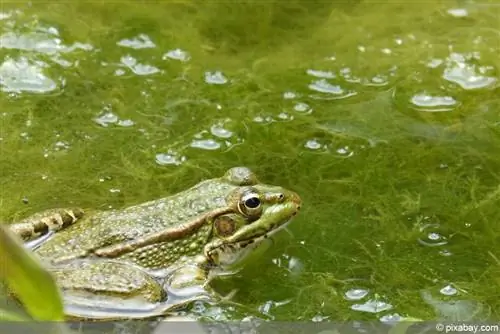
The conventional garden pond is also suitable as a body of water for overwintering some species of frogs. The prerequisite is that there is sufficient oxygen content in the pond water. This is no longer the case when pond surfaces freeze completely. Without “auxiliary aids”, air exchange can no longer take place and, under certain circumstances, even oxygen in the water can be used up in a life-threatening manner, for example through sludge.
Aids are for example:
- Continuously running filter or oxygen pump
- Reed grasses used in the pond, through which air exchange can take place
- Alternatively, reed bundles have the same effect as inserted plants
- Oxygen-producing underwater plants, such as hornleaf
In addition, you can make some preparations to improve the quality of life underwater and prevent frog deaths:
- Removing sludge
- Remove dead plant parts, leaves and the like from the pond in autumn
- Removing mold from the roots of aquatic plants
In addition, you should avoid disturbances such as ice skating on frozen ponds and breaking or breaking up the ice layer to allow oxygen to be exchanged. This leads to stress in the frogs in hibernation and they could briefly “wake up” from it. This in turn costs them unnecessary oxygen, which may not be available under water. Frog death is often the result.
By the way, a garden pond should measure at least 50 centimeters at its deepest point, and preferably 80 centimeters, because the lower a garden pond is, the colder the water in the base area becomes.
Dangers
The hoppers wander around in large numbers in autumn in search of a place to overwinter. The expert also speaks here of a toad migration. They can often be seen crossing roads, especially during this time. Thousands of frogs and toads die here every year, so animal rights activists volunteer to protect the animals from being run over. You too can do your part by paying careful attention and paying special attention to possible croakers on the edges of the road and on the road in the autumn and, if possible, avoiding them as much as possible.
If your property is on a busy street, you can prevent the hoppers from crossing with special fences. If some specimens are caught in it, either carry them across the road or place them directly in a forest or near a stream, pond or river.
It is not uncommon for this amphibian species to hide under manhole covers or in cellar shafts. Getting in is usually not the problem for them, but rather getting out in the spring. For this reason, you should make all air and light shafts and water pipe systems on your property inaccessible to frogs and toads by mid-September at the latest. To do this, you can attach a fine-mesh wire or mesh over the openings. If an animal has already settled here, use an exit aid carefully and ideally quietly. This could be, for example, a wooden plank that leads diagonally to the exit.
Conclusion
Frogs and toads hibernate by their bodies adapting to the cold temperatures and spending the cold winter months motionless in hibernation on land or under water. Even though they always choose protective places and do not need food even during the hibernation period, the number of frogs dying is still increasing. A lack of peace and quiet, increasing road traffic and recklessness on the part of drivers as well as people's wrong actions contribute a large part to this. With just a little effort, you can make your pond or other garden areas winter-proof for frogs and save some of these jumping animals from being run over.

